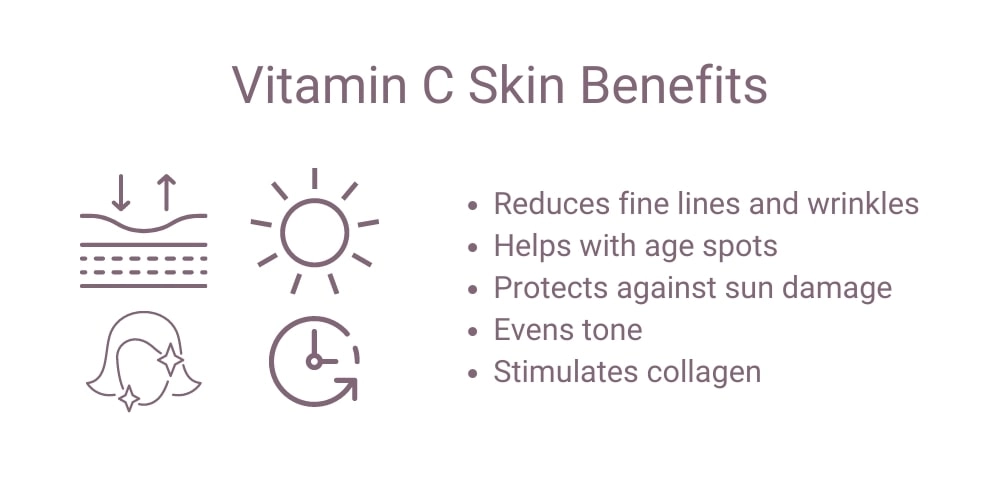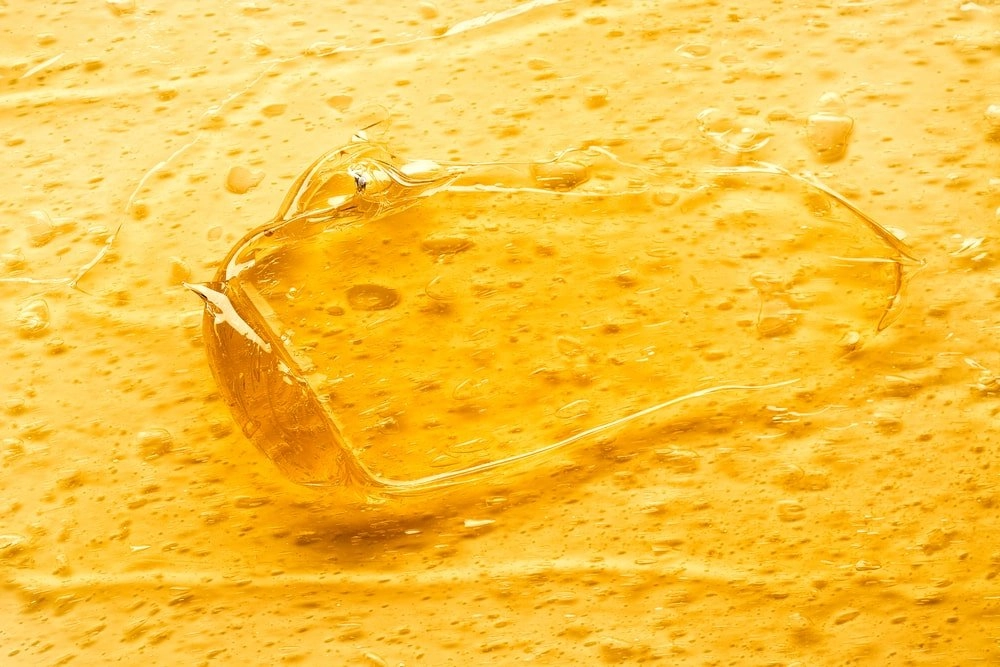Vitamin C is renowned for its myriad benefits in skincare, offering brightening and anti-aging effects backed by scientific evidence. However, understanding the different types of vitamin C can be crucial for optimal skincare.
On the surface, using a product with vitamin C sounds simple. But unless you’re reading the back of the label, you might not be aware there are different types of vitamin C.
Ascorbic acid or L-ascorbic acid is the pure form of vitamin C. It’s an antioxidant powerhouse that delivers amazing benefits to the skin. This ingredient is potent but it’s not stable. Sometimes it irritates the skin.

So, many different forms of vitamin C were created to be more stable and make product formulation easier. Sounds great right?
However, the challenge lies in the fact that these forms vary, and they may not be as effective as pure ascorbic acid.
This post may contain affiliate links. Read the full disclosure here
What is the Best Type of Vitamin C for Skin?
L-ascorbic acid is the best type of vitamin C. Ascorbic acid is the most potent, beneficial, and pure form of vitamin C. Other forms of vitamin C such as magnesium ascorbyl phosphate or tetrahexyldecyl ascorbate can be less irritating but are less effective.

To get maximum results from vitamin C, look for products that formulate L-ascorbic acid with ferulic acid and vitamin E. This combo can make vitamin C more effective and helps stabilize.
If sensitive skin is a concern, others forms of vitamin C such as tetrahexyldecyl ascorbate and ascorbyl glucoside are good options to try.
What is L-ascorbic acid?
L-ascorbic acid is pure vitamin C and the most effective type for the skin. It’s the gold standard when it comes to vitamin C. It’s the purest form that is naturally in citrus fruits, plants, green vegetables, and in our skin. Most clinical studies showing the proven benefits of vitamin C for the skin are based on ascorbic acid.
L-ascorbic acid is also referred to as simply ascorbic acid. They’re the same thing. The “L” in front of ascorbic acid refers to the way the molecule rotates to light.
How Does it Compare?
L-ascorbic acid is the most biologically active, making it a very effective vitamin C option. We have lots of l-ascorbic in our bodies. But we can’t produce it. This powerful antioxidant comes from our diet. Of course, applying l-ascorbic acid is the best way to deliver the benefits directly to the skin.
It can help even skin tone, support collagen production, and protect against skin damage. While L-ascorbic acid is effective, it’s an unstable molecule. L-ascorbic acid needs to be formulated with water-based ingredients, antioxidants, and with a low PH to keep it stable. It also needs to be formulated at the PH for it to absorb properly (around 3.5) into the skin.
Look for products that use ferulic acid and vitamin E. These ingredients can help stabilize vitamin C, help it penetrate the skin, and can increase its effectiveness.
Also, keep in mind products with L-ascorbic acid may not have a long shelf life.
Sodium Ascorbyl Phosphate
Sodium ascorbyl phosphate is a water-soluble form of vitamin C. This form is gentler on the skin compared to L-ascorbic acid and it is more stable. This vitamin C derivative helps brighten the skin, even, tone, increases collagen products, fights free radicals, and it has antimicrobial benefits.
How Does it Compare?
One study found sodium ascorbyl phosphate was more stable than magnesium ascorbyl phosphate and L-ascorbic acid.
Sodium ascorbyl is a salt that converts into ascorbic acid when applied to the skin. While sodium ascorbyl phosphate is less likely to irritate the skin, it’s also less effective than L-ascorbic acid. It’s still a great option it just not as potent as L-ascorbic acid.
Sodium Ascorbate
Sodium ascorbate is a water-soluble form of vitamin C. It’s a sodium salt made by replacing the 3-hydroxy group of ascorbic acid with a sodium ion.
Similar to sodium ascorbyl phosphate, is easier on the skin compared to L-ascorbic acid but is also less effective. This type of vitamin C is stable and converts to ascorbic acid when applied to the skin. It is also known as mineral ascorbate.
How Does it Compare?
While sodium ascorbate is more stable than pure ascorbic acid, it’s less effective. However, sodium ascorbate is less likely to irritate the skin than ascorbic acid.
Similar to sodium ascorbyl phosphate, sodium ascorbate converts to ascorbic acid in the skin. It’s not known how much the levels of ascorbic acid increase in the skin when sodium ascorbate is applied.
Calcium Ascorbate
Calcium ascorbate (CAAS) is a mineral salt of ascorbic acid, sometimes referred to as Ester C. It’s around 10% calcium by mass. It helps promote collagen production, fight the signs of aging, and even complexion.
How Does It Compare?
Calcium ascorbate is more stable and less likely to irritate the skin compared to ascorbic acid. But it’s also less potent than ascorbic acid. Is this starting to sound familiar yet?
One study found calcium ascorbate is more effective at hydrating the skin compared to ascorbic acid. Calcium ascorbate effective and stable at a neutral PH, making it less likely to irritate the skin.
Magnesium Ascorbyl Phosphate
Magnesium ascorbyl phosphate (MAP) is a water-soluble form of vitamin C. This stable antioxidant combines ascorbic acid and magnesium salt. It helps increase collagen production, fight free radicals, visibly reduce age spots and hyperpigmentation, and helps maintain hydration.
Similar to other vitamin C derivatives, magnesium ascorbyl phosphate converts to ascorbic acid when applied to the skin. This type of vitamin C is in products by The Ordinary, Paula’s Choice, and First Aid Beauty.
How Does It Compare?
Magnesium ascorbyl phosphate is more stable and less irritating than L-ascorbic acid. While this is great for product formulation, magnesium ascorbyl phosphate is likely less effective than pure ascorbic acid. Since the ascorbic acid conversion rate is unknown it may not offer the same benefits to the skin.
Ascorbyl Glucoside
Ascorbyl glucoside is a water-soluble form of vitamin C that combines glucose and ascorbic acid. It promotes collagen production, fights free radicals, brightens complexion, and helps even skin tone.
When ascorbyl glucoside is applied to the skin, an enzyme called alpha-glucosidas breaks down into ascorbic acid. This version of vitamin C is in products made by The Ordinary, La Roche-Posay, Clinique, Dermalogica, and Drunk Elephant.
How Does it Compare?
Ascorbyl glucoside is more stable than L-ascorbic acid and less likely to irritate the skin. This gentler form is effective at neutral PH levels and is gentler on the skin. It’s not as potent as pure ascorbic acid but it is a popular derivative in skincare.
Tetrahexyldecyl Ascorbate
Tetrahexyldecyl ascorbate is an oil-soluble form of vitamin C. This is another derivative of vitamin C that is more stable, making it easier to formulate with different ingredients.
Tetrahexyldecyl ascorbate (BV-OSC) was created by a company called Barnett. Based on their research, they found THD offers the following skin benefits:
- Reduces melatonin synthesis by 80%
- Eliminates age spots in 16 weeks
- Increases collagen by 50% (in vitro)
- Penetrates the skin 4 times better than magnesium ascorbyl phosphate.
- Delivers pure Vitamin C 50 times better than ascorbic acid
This research was conducted by Barnett, the creators of tetrahexyldecyl ascorbate. Not all of the research is based on humans but the results look promising.
How Does it Compare?
Since tetrahexyldecyl ascorbate is oil-soluble it can penetrate the skin better than L-ascorbic acid. However, to provide the core vitamin C benefits, it needs to convert to ascorbic acid when applied to the skin. There is limited data on the effectiveness of this conversion.

The research by Barnett shows tetrahexyldecyl ascorbate is more effective at delivering pure vitamin C than ascorbic acid. This is quite impressive but it isn’t yet backed up by external claims.
The same research also shows tetrahexyldecyl ascorbate takes longer than ascorbic acid to effectively neutralize free radicals.
Tetrahexyldecyl ascorbate took 48 hours to reach 100% effectiveness at fighting free radicals but ascorbic acid was 100% effective within 30 minutes of applying to the skin.
Ascorbyl Palmitate
Ascorbyl palmitate is an oil-soluble form of vitamin C. It’s an ester that combines ascorbic acid and palmitic acid. It helps promote collagen production, reduces the appearance of age spots, and improves skin texture.
This form of ascorbic acid is a potent antioxidant that helps protect lipids and is a free radical scavenger.
How Does it Compare?
Ascorbyl palmitate is more stable than ascorbic acid and less likely to irritate the skin. It may not be as effective as pure vitamin C, but it’s still a beneficial ingredient. Since ascorbyl palmitate is fat-soluble it absorbs into the skin better than L-ascorbic acid.
Vitamin C Skin Benefits
Vitamin C is a powerful antioxidant. When used correctly, and the right type is used, it provides amazing benefits for the skin. It promotes collagen production, reduces the appearance of age spots, brightens the skin, neutralizes free radicals, and visibly reduces fine lines and wrinkles.

- Protects against premature aging – Vitamin C helps fight free radicals caused by sun damage or environmental stressors that can lead to premature aging.
- Even tone – Ascorbic acid can help fade age spots and reduce the appearance of hyperpigmentation.
- Promotes collagen production – Applying vitamin C to the skin can help increase collagen production on younger and mature skin.
- Anti-inflammatory properties – It has anti-inflammatory properties that promote wound healing and can help with conditions such as acne and rosacea.
- Brightens skin – It helps even skin tone and smooth texture to reveal a bright, glowing complexion.
- Protects the skin – Vitamin C helps protect the skin against sun damage. It neutralizes free radicals that can lead to skin damage and premature aging.
Vitamin C Concentration Levels
If a little bit of something is good, then more is even better right? Well, that isn’t the case with vitamin C concentration. Look for products that use a 10-20% vitamin C concentration.

Using products that have a concentration above 20% can irritate the skin, without any additional benefits. However, opt for products that contain at least a 10% concentration to experience the skin benefits.
Frequently Asked Questions
Find answers to some of the most frequently asked questions about vitamin C.
Related Articles You Might Like:




